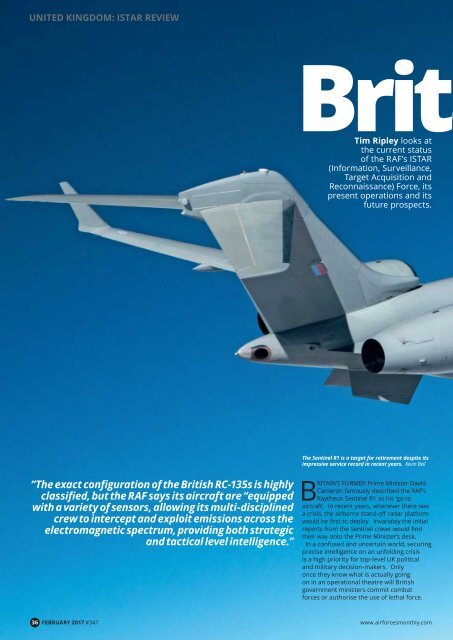Airforces Monthly - February 2017
You also want an ePaper? Increase the reach of your titles
YUMPU automatically turns print PDFs into web optimized ePapers that Google loves.
Brita<br />
Tim Ripley looks at<br />
the current status<br />
of the RAF’s ISTAR<br />
(Information, Surveillance,<br />
Target Acquisition and<br />
Reconnaissance) Force, its<br />
present operations and its<br />
future prospects.<br />
UNITED KINGDOM: ISTAR REVIEW<br />
The Sentinel R1 is a target for retirement despite its<br />
impressive service record in recent years. Kevin Bell<br />
“The exact configuration of the British RC-135s is highly<br />
classified, but the RAF says its aircraft are “equipped<br />
with a variety of sensors, allowing its multi-disciplined<br />
crew to intercept and exploit emissions across the<br />
electromagnetic spectrum, providing both strategic<br />
and tactical level intelligence.”<br />
BRITAIN’S FORMER Prime Minister David<br />
Cameron famously described the RAF’s<br />
Raytheon Sentinel R1 as his ‘go-to<br />
aircraft’. In recent years, whenever there was<br />
a crisis, the airborne stand-off radar platform<br />
would be first to deploy. Invariably the initial<br />
reports from the Sentinel crews would find<br />
their way onto the Prime Minister’s desk.<br />
In a confused and uncertain world, securing<br />
precise intelligence on an unfolding crisis<br />
is a high priority for top-level UK political<br />
and military decision-makers. Only<br />
once they know what is actually going<br />
on in an operational theatre will British<br />
government ministers commit combat<br />
forces or authorise the use of lethal force.<br />
36 FEBRUARY <strong>2017</strong> #347 www.airforcesmonthly.com


